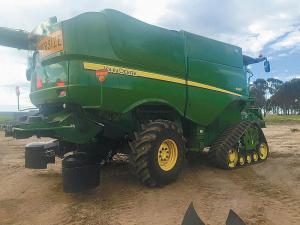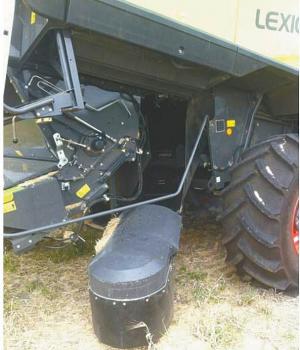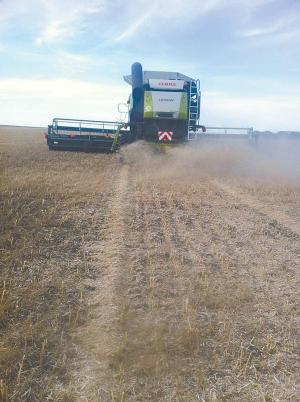2018 - Volume #42, Issue #2, Page #17
[ Sample Stories From This Issue | List of All Stories In This Issue | Print this story
| Read this issue]
Control Weeds By Controlling Chaff
 |
 |
 |
“The Chaff Deck is a weed control tool, just like pre-emerge and post-emerge herbicides,” says Peter Broley, Primary Sales. “The chaff contains 95 percent of the weed seeds that go into the front of the combine. What farmers do now is to spread the chaff and the seeds across the field. The Chaff Deck’s enclosed conveyor belts drop the weed seeds and chaff onto the wheel tracks of the combine.”
Broley reports that harvest time weed seed control can reduce field weed seed banks by 60 percent in 3 to 5 years. In the past, efforts have included chaff carts, burning and attachments like the Harrington Seed Destructor (Vol. 36, No. 2). However, burning is often restricted and damages soil health. Chaff carts and the Destructor impact the combine and increase fuel consumption.
“Once the chaff was collected, you had to burn it or bring in sheep to eat it,” says Broley. “Chaff Decks are a simple solution that don’t take much power and leave the seeds where they can be controlled.”
Leaving them in the wheel tracks means the majority of the field has fewer weed seeds. It also means that herbicide used the following year can be concentrated over the wheel tracks with less herbicide needed elsewhere.
“One Chaff Deck user uses larger nozzles over the wheel tracks to put more material on there with nothing over the rest of the field,” says Broley.
Even without herbicides, the Chaff Decks are beneficial. In a wet year, the concentrated chaff and weed seeds are likely to compost. Until they do, the residue helps support wheel traffic. In a dry year, the decomposing chaff holds down the dust.
Installation of the Chaff Deck kit is simple and can be done by the farmer or his dealer. Remove the chaff spreaders, bolt the Chaff Decks in their place and link them to existing hydraulics and electronics. Sensors are installed to monitor chaff movement and conveyor operation from the cab. Time to install can vary from a few hours with some brands to requiring two people and a day’s time on more complicated systems like Deere.
Cost also varies depending on the brand and the level of complication. “Chaff Decks for New Holland combines cost around $14,000 (U.S.) with Deere around $19,500,” says Broley. “Once the Chaff Decks are on, you can leave them on. Working on the combine sieves just requires removing 2 bolts and a pin to slide the Chaff Deck out of the way. It only takes a couple of minutes.”
Broley notes that while the Chaff Decks haven’t been used for harvesting corn, they work fine with soybeans and small grains, as well as canola and barley.
Currently the company is seeking distributors and dealers in the U.S. and Canada. Chaff Decks are already being marketed in Australia, New Zealand and the United Kingdom. Check them out at FARMSHOW.com.
Contact: FARM SHOW Followup, Primary Sales, 44 Meliador Way, Midvale W.A. 6056 (ph 61 (08) 9250 3500; sales@primarysales.com.au; www.primarysales.com.au).

Click here to download page story appeared in.

Click here to read entire issue
To read the rest of this story, download this issue below or click here to register with your account number.




